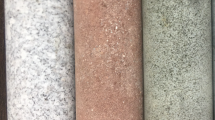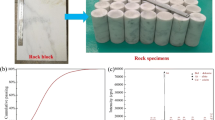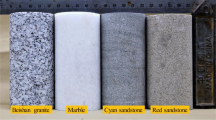Abstract
Crack evolution in a rock depends on the mineralogy, microstructure and fabric of specific rock type. This study aims to investigate how mineralogy and grain shape affect the microcrack initiation and propagation of granite rock, which contains plagioclase, quartz, k-feldspar, biotite and amphibole, during uniaxial compression loading. Physico-mechanical properties and microcrack features such as linear microcrack density (LMD) and microcrack type were investigated. By acoustic emission (AE) measurements, damage stress thresholds were identified. Then, crack characteristics of a fresh sample were compared with the samples that were loaded until damage threshold stresses. The results demonstrate that at an early stage of loading, pre-existing microcracks growth and LMD of intergranular crack increase. In the elastic phase, all microcracks types increase at the same rate. When the loading reaches to the strength limit of the sample, the total LMD reduced, because cracks start to coalesce and form new and large transgranular microcrack. Investigating crack propagation in mineral shows that at first, microcrack generates in biotite and at last in quartz. Plagioclase has the highest LMD and microcracks usually formed within the cleavage plane, but alteration and inclusions of tiny minerals can drastically change the LMD and orientation of microcracks. Biotite can terminate or let the microcrack to pass through the crystal based on the orientation of the microcrack plane and cleavage microcrack within the mineral. Furthermore, crystals with an aspect ratio higher than two have higher LMD. By getting close to the uniaxial compression strength, more microcracks appear close to the grain boundary which increases the circularity of the grain.















Similar content being viewed by others
References
Akesson U, Hansson J, Stigh J (2004) Characterisation of microcracks in the Bohus granite, western Sweden, caused by uniaxial cyclic loading. Eng Geol 72:131–142. https://doi.org/10.1016/j.enggeo.2003.07.001
Alm O, Jaktlund L-L, Shaoquan K (1985) The influence of microcrack density on the elastic and fracture mechanical properties of Stripa granite. Phys Earth Planet Inter 40:161–179. https://doi.org/10.1016/0031-9201(85)90127-X
Cai M, Kaiser P, Tasaka Y, Maejima T, Morioka H, Minami M (2004) Generalized crack initiation and crack damage stress thresholds of brittle rock masses near underground excavations. Int J Rock Mech Min Sci 41:833–847. https://doi.org/10.1016/j.ijrmms.2004.02.001
Cao R-H, Cao P, Lin H, Pu C-Z, Ou K (2016) Mechanical behavior of brittle rock-like specimens with pre-existing fissures under uniaxial loading: experimental studies and particle mechanics approach. Rock Mech Rock Eng 49:763–783. https://doi.org/10.1007/s00603-015-0779-x
Chen S, Yue Z, Tham L (2004) Digital image-based numerical modeling method for prediction of inhomogeneous rock failure. Int J Rock Mech Min Sci 41:939–957. https://doi.org/10.1016/j.ijrmms.2004.03.002
Chen Y, Watanabe K, Kusuda H, Kusaka E, Mabuchi M (2011) Crack growth in Westerly granite during a cyclic loading test. Eng Geol 117:189–197. https://doi.org/10.1016/j.enggeo.2010.10.017
Diederichs M, Kaiser P, Eberhardt E (2004) Damage initiation and propagation in hard rock during tunnelling and the influence of near-face stress rotation. Int J Rock Mech Min Sci 41:785–812. https://doi.org/10.1016/j.ijrmms.2004.02.003
Dreyer W (1972) The science of rock mechanics, part 1: the strength properties of rocks vol 1. vol 2
Eberhardt E, Stead D, Stimpson B, Read R (1998) Identifying crack initiation and propagation thresholds in brittle rock. Can Geotech J 35:222–233. https://doi.org/10.1139/t97-091
Eberhardt E, Stead D, Stimpson B (1999) Quantifying progressive pre-peak brittle fracture damage in rock during uniaxial compression. Int J Rock Mech Min Sci 36:361–380. https://doi.org/10.1016/S0148-9062(99)00019-4
Erarslan N (2016) Microstructural investigation of subcritical crack propagation and fracture process zone (FPZ) by the reduction of rock fracture toughness under cyclic loading. Eng Geol 208:181–190. https://doi.org/10.1016/j.enggeo.2016.04.035
Ersoy A, Waller M (1995) Textural characterisation of rocks. Eng Geol 39:123–136. https://doi.org/10.1016/0013-7952(95)00005-Z
Fredrich JT, Wong TF (1986) Micromechanics of thermally induced cracking in three crustal rocks. J Geophys Res Solid Earth 91:12743–12764. https://doi.org/10.1029/JB091iB12p12743
Freire-Lista D, Fort R (2017) Exfoliation microcracks in building granite. Implications for anisotropy. Eng Geol 220:85–93. https://doi.org/10.1016/j.enggeo.2017.01.027
Freire-Lista DM, Fort R, Varas-Muriel MJ (2015) Freeze–thaw fracturing in building granites. Cold Regions Sci Technol 113:40–51. https://doi.org/10.1016/j.coldregions.2015.01.008
Gupta IN (1973) Seismic velocities in rock subjected to axial loading up to shear fracture. J Geophys Res 78:6936–6942. https://doi.org/10.1029/JB078i029p06936
Hoek E, Bieniawski Z (1966) Fracture propagation mechanism in hard rock. In: 1st ISRM Congress, 1966. International Society for Rock Mechanics
Hoseinie S, Ataei M, Mikaeil R (2017) Effects of microfabric on drillability of rocks. Bull Eng Geol Environ. https://doi.org/10.1007/s1006
Howarth DF, Rowlands JC (1986) Development of an index to quantify rock texture for qualitative assessment of intact rock properties. Geotech Test J 9:169–179. https://doi.org/10.1520/GTJ10627J
Howarth D, Rowlands J (1987) Quantitative assessment of rock texture and correlation with drillability and strength properties. Rock Mech Rock Eng 20:57–85. https://doi.org/10.1007/BF01019511
Irfan T (1996) Mineralogy, fabric properties and classification of weathered granites in Hong Kong. Q J Eng Geol Hydrogeol 29:5–35. https://doi.org/10.1144/GSL.QJEGH.1996.029.P1.02
ISRM (2007) Suggested method for rock characterization, testing and monitoring, ISRM Commission on Testing Methods. Pergamon Press, Oxford. https://doi.org/10.1007/978-3-319-07713-0
Kallimogiannis V, Saroglou H, Tsiambaos G (2017) Study of cracking process in granite. In: ISRM European Rock Mechanics Symposium-EUROCK 2017. International Society for Rock Mechanics and Rock Engineering. https://doi.org/10.1016/j.proeng.2017.05.285
Khalil YS, Arif M, Bangash HA, Sajid M, Muhammad N (2015) Petrographic and structural controls on geotechnical feasibility of dam sites: implications from investigation at Sher Dara area (Swabi), north-western Pakistan. Arab J Geosci 8:5067–5079. https://doi.org/10.1007/s12517-014-1510-z
Kowallis BJ, Wang HF (1983) Microcrack study of granitic cores from Illinois deep borehole UPH 3. J Geophys Res Solid Earth 88:7373–7380. https://doi.org/10.1029/JB088iB09p07373
Kranz RL (1979) Crack growth and development during creep of Barre granite. International Journal of Rock Mechanics and Mining Sciences & Geomechanics Abstracts, vol 1. Elsevier, Amsterdam, pp 23–35. https://doi.org/10.1016/0148-9062(79)90772-1
Kranz RL (1983) Microcracks in rocks: a review. Tectonophysics 100:449–480. https://doi.org/10.1016/0040-1951(83)90198-1
Kudo Y, Sano O, Murashige N, Mizuta Y, Nakagawa K (1992) Stress-induced crack path in Aji granite under tensile stress. Pure Appl Geophys 138:641–656. https://doi.org/10.1007/BF00876342
Lan H, Martin CD, Hu B (2010) Effect of heterogeneity of brittle rock on micromechanical extensile behavior during compression loading. J Geophys Res Solid Earth. https://doi.org/10.1029/2009JB006496
Mahabadi O, Randall N, Zong Z, Grasselli G (2012) A novel approach for micro-scale characterization and modeling of geomaterials incorporating actual material heterogeneity. Geophys Res Lett. https://doi.org/10.1029/2011GL050411
Martin C, Chandler N (1994) The progressive fracture of Lac du Bonnet granite. International Journal of Rock Mechanics and Mining Sciences & Geomechanics Abstracts, vol 6. Elsevier, Amsterdam, pp 643–659. https://doi.org/10.1016/0148-9062(94)90005-1
Masoudi F, Yardley B (2005) Magmatic and metamorphic fluids in pegmatite development: evidence from Borujerd Complex. Iran J Sci, Islamic Republic of Iran 16:43–53
Munoz H, Taheri A (2017) Local damage and progressive localisation in porous sandstone during cyclic loading. Rock Mech Rock Eng 50(12):3253–3259. https://doi.org/10.1007/s00603-017-1298-8
Munoz H, Taheri A, Chanda E (2016) Fracture energy-based brittleness index development and brittleness quantification by pre-peak strength parameters in rock uniaxial compression. Rock Mech Rock Eng 49(12):4587–4606. https://doi.org/10.1007/s00603-016-1071-4
Nicksiar M (2013) Effective parameters on crack initiation stress in low porosity rocks. University of Alberta (Canada)
Nur A, Simmons G (1970) The origin of small cracks in igneous rocks. International Journal of Rock Mechanics and Mining Sciences & Geomechanics Abstracts, vol 3. Elsevier, Amsterdam, pp 307–314. https://doi.org/10.1016/0148-9062(70)90044-6
Onodera T, Asoka Kumara H (1980) Relation between texture and mechanical properties of crystalline rocks. Bull Int Assoc Eng Geol 22:173–177
Petruk W (1986) Image analysis: “an overview of developments”. CANMET Report 86-4E, p 5. https://doi.org/10.4095/307280
Přikryl R (2001) Some microstructural aspects of strength variation in rocks. Int J Rock Mech Min Sci 38:671–682. https://doi.org/10.1016/S1365-1609(01)00031-4
Prodaivoda G, Maslov B, Prodaivoda T (2004) Thermoelastic properties of rock-forming minerals. Russ Geol Geophys 45:389–404
Rasouli J, Ahadnejad V, Esmaeily D (2012) A preliminary study of the anisotropy of magnetic susceptibility (AMS) of Boroujerd granitoids, Sanandaj-Sirjan Zone. West Iran Natural science 4:91. https://doi.org/10.4236/ns.2012.42014
Rawling GC, Baud P, Tf Wong (2002) Dilatancy, brittle strength, and anisotropy of foliated rocks: experimental deformation and micromechanical modeling. J Geophys Res Solid Earth. https://doi.org/10.1029/2001JB000472
Rigopoulos I, Tsikouras B, Pomonis P, Hatzipanagiotou K (2013) Petrographic investigation of microcrack initiation in mafic ophiolitic rocks under uniaxial compression. Rock Mech Rock Eng 46:1061–1072. https://doi.org/10.1007/s00603-012-0310-6
Sajid M, Arif M (2015) Reliance of physico-mechanical properties on petrographic characteristics: consequences from the study of Utla granites, north-west Pakistan. Bull Eng Geol Environ 74:1321–1330. https://doi.org/10.1007/s10064-014-0690-9
Sajid M, Coggan J, Arif M, Andersen J, Rollinson G (2016) Petrographic features as an effective indicator for the variation in strength of granites. Eng Geol 202:44–54. https://doi.org/10.1016/j.enggeo.2016.01.001
Schild M, Siegesmund S, Vollbrecht A, Mazurek M (2001) Characterization of granite matrix porosity and pore-space geometry by in situ and laboratory methods. Geophys J Int 146:111–125. https://doi.org/10.1046/j.0956-540x.2001.01427.x
Scholz C (1968) Microfracturing and the inelastic deformation of rock in compression. J Geophys Res 73:1417–1432. https://doi.org/10.1029/JB073i004p01417
Seo Y, Jeong G, Kim J, Ichikawa Y (2002) Microscopic observation and contact stress analysis of granite under compression. Eng Geol 63:259–275. https://doi.org/10.1016/S0013-7952(01)00086-2
Sepahi AA, Athari SF (2006) Petrology of major granitic plutons of the northwestern part of the Sanandaj-Sirjan Metamorphic Belt, Zagros Orogen, Iran: with emphasis on A-type granitoids from the SE Saqqez area. Neues Jahrbuch für Mineralogie-Abhandlungen: J Mineral Geochem 183:93–106. https://doi.org/10.1127/0077-7757/2006/0063
Sousa LM (2013) The influence of the characteristics of quartz and mineral deterioration on the strength of granitic dimensional stones. Environ Earth Sci 69:1333–1346. https://doi.org/10.1007/s12665-012-2036-x
Sousa LMO, del Rio LMS, Calleja L, de Argandona VGR, Rey AR (2005) Influence of microfractures and porosity on the physico-mechanical properties and weathering of ornamental granites. Eng Geol 77:153–168. https://doi.org/10.1016/j.enggeo.2004.10.001
Taheri A, Yfantidis N, Olivares C, Connelly B, Bastian T (2016) Experimental study on degradation of mechanical properties of sandstone under different cyclic loadings. Geotech Test J 39:673–687. https://doi.org/10.1520/GTJ20150231
Tandon RS, Gupta V (2013) The control of mineral constituents and textural characteristics on the petrophysical & mechanical (PM) properties of different rocks of the Himalaya. Eng Geol 153:125–143. https://doi.org/10.1016/j.enggeo.2012.11.005
Tapponnier P, Brace W (1976) Development of stress-induced microcracks in Westerly granite. Int J Rock Mech Min Sci Geomech Abstr 13:103–112. https://doi.org/10.1016/0148-9062(76)91937-9
Tuğrul A, Zarif I (1999) Correlation of mineralogical and textural characteristics with engineering properties of selected granitic rocks from Turkey. Eng Geol 51:303–317. https://doi.org/10.1016/S0013-7952(98)00071-4
Ündül Ö, Amann F, Aysal N, Plötze M (2013) Micro-textural controlled variations of the geomechanical properties of andesites. Eurock 2013:357–361
Ündül Ö, Amann F, Aysal N, Plötze ML (2015) Micro-textural effects on crack initiation and crack propagation of andesitic rocks. Eng Geol 193:267–275. https://doi.org/10.1016/j.enggeo.2015.04.024
Williams H, Turner FJ, Gilbert CM, Turner FJ (1982) Petrography: an introduction to the study of rocks in thin sections. WH Freeman San Francisco. https://doi.org/10.1002/gj.3350010315
Yushi Z, Shicheng Z, Tong Z, Xiang Z, Tiankui G (2016) Experimental investigation into hydraulic fracture network propagation in gas shales using CT scanning technology. Rock Mech Rock Eng 49:33–45. https://doi.org/10.1007/s00603-015-0720-3
Zalooli A, Freire-Lista DM, Khamehchiyan M, Nikudel MR, Fort R, Ghasemi S (2018) Ghaleh-khargushi rhyodacite and Gorid andesite from Iran: characterization, uses, and durability. Environ Earth Sci 77:315. https://doi.org/10.1007/s12665-018-7485-4
Zhao X, Cai M, Wang J, Ma L (2013) Damage stress and acoustic emission characteristics of the Beishan granite. Int J Rock Mech Mining Sci. https://doi.org/10.1016/j.ijrmms.2013.09.003
Zhou J, Xu W, Yang X (2010) A microcrack damage model for brittle rocks under uniaxial compression. Mech Res Commun 37:399–405. https://doi.org/10.1016/j.mechrescom.2010.05.001
Zhou S, Xia C, Zhou Y (2018) A theoretical approach to quantify the effect of random cracks on rock deformation in uniaxial compression. J Geophys Eng 15:627. https://doi.org/10.1088/1742-2140/aaa1ad
Acknowledgements
Tarbiat Modares University of Tehran (Iran) funded this project. Ministry of Science and Technology of Iran provided financial support to the first author to stay at The University of Adelaide Australia for six months. We are grateful to Dr. M. Ahmadi (School of Engineering, Tarbiat Modares University) for his help to perform AE tests, Mohammad Yusefi (XRD and XRF laboratory technician of Tarbiat Modares University) and also School of Earth and Environmental Sciences of The University of Adelaide for giving us access to their microscopic facilities.
Author information
Authors and Affiliations
Corresponding author
Additional information
Publisher's Note
Springer Nature remains neutral with regard to jurisdictional claims in published maps and institutional affiliations.
Rights and permissions
About this article
Cite this article
Ghasemi, S., Khamehchiyan, M., Taheri, A. et al. Crack Evolution in Damage Stress Thresholds in Different Minerals of Granite Rock. Rock Mech Rock Eng 53, 1163–1178 (2020). https://doi.org/10.1007/s00603-019-01964-9
Received:
Accepted:
Published:
Issue Date:
DOI: https://doi.org/10.1007/s00603-019-01964-9




